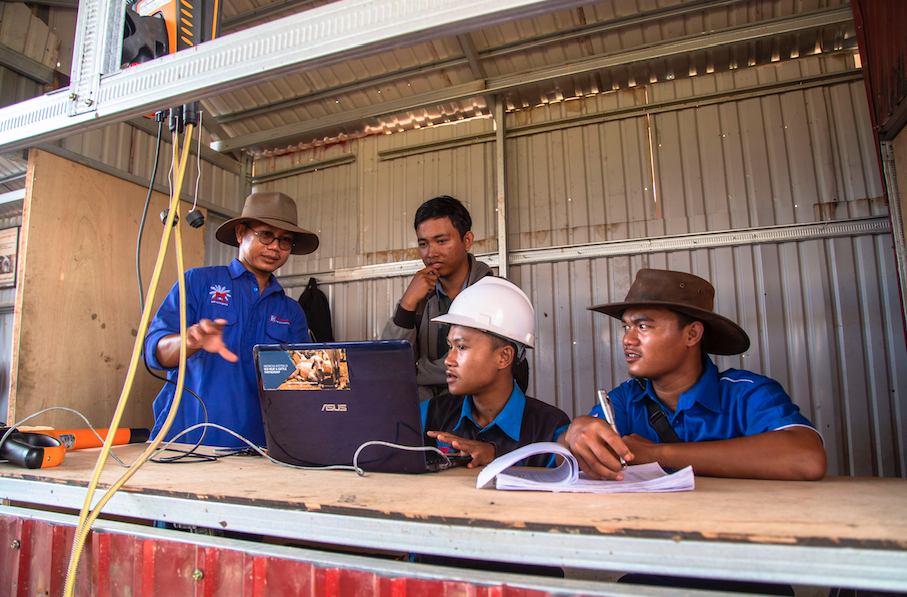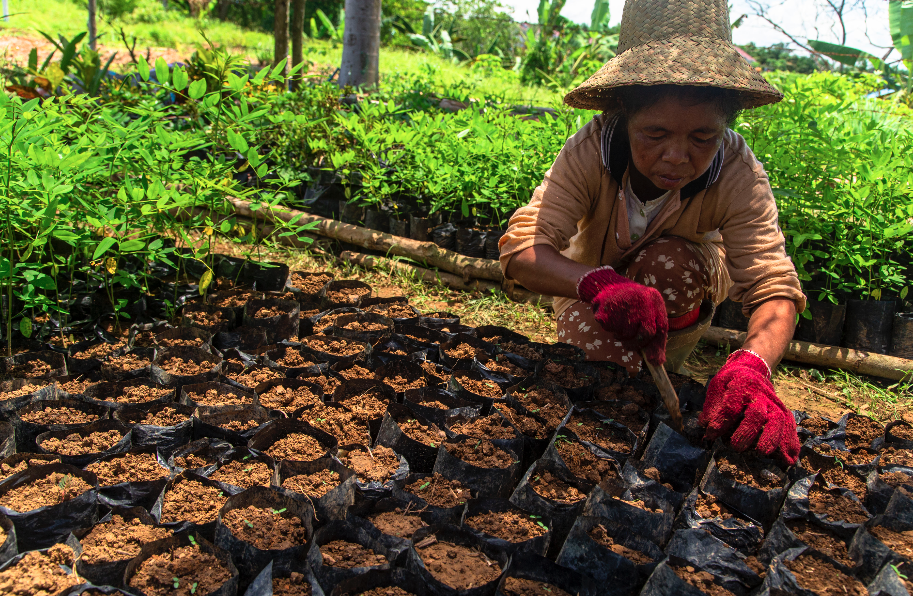Breeding Program Leaves a Lasting Legacy
Conducted over five years from February 2016 to February 2021, the Indonesia-Australia Commercial Cattle Breeding Program (IACCB) has changed the face of beef cattle breeding in Indonesia.
IACCB has been hailed by leading cattle industry veterinarian, Dr Ross Ainsworth, as “the best and most successful program I have worked on in 30 years”.
With a budget of AUD $9.1 million over five years, the program aimed to establish commercially sustainable cattle breeding models that would lead to investment, innovation, and expansion of the beef cattle industry in Indonesia.
Over its duration, IACCB saw herd numbers in partner operations increase by 100%, with more than 2,500 calves born, while scaling-up strategies are forecasting a 2026 closing herd stock in excess of 6,000 cattle.
This successful collaboration has drawn plaudits from senior Australian and Indonesian government representatives.
“I really appreciate that IACCB has been very active in building relations and sharing its findings with the Government of Indonesia, especially the Ministry of Agriculture,” says Sugiono, Director of Livestock Breeding and Production in Indonesia’s Ministry of Agriculture.
George Hughes, Agriculture Counsellor at the Australian Embassy in Indonesia, agrees.
“The IACCB Program has helped bring all stakeholders together and has improved relationships between our two countries,” Mr Hughes said. “It has definitely improved the Government of Australia’s understanding of cattle breeding in Indonesia.”
Encouragingly, at program closure, IACCB partners had already invested around AUD $5.75 million in their cattle businesses, indicating their confidence in the breeding models and their ability to drive further growth without direct IACCB support.
“We understand now that the key to cattle breeding is management,” says Suhadi, head of the Koperasi Produksi Ternak Maju Sejahtera (KPT-MS) smallholder cooperative in Lampung.
“Through our partnership with IACCB, we have to date sold 213 calves worth Rp2.1 billion.”
FINAL ASSESSMENT OF THE BREEDING MODELS
The IACCB Program tested four cattle breeding models: integrated oil palm and cattle production (SISKA); open grazing; a cut and carry model, where smallholder farmers manage cattle in a stockyard; and the SISKA breedlot model, where cattle graze in an oil palm plantation for around six months, prior to being placed in a breedlot before calving.
To assess all models for their commercial viability, IACCB partnered with eight project partners across five provinces and provided them with Brahman Cross cattle and high-quality technical assistance.
Production and financial data covering all four cattle breeding models were compiled from each partner over a four-year period, enabling IACCB to make confident judgments on the commercial viability of each model.
All four cattle breeding models were deemed to be commercially viable, although results were dependent on continuous professional cattle management.
SISKA, when implemented by large palm oil operators with sufficient land and capital, offers the best opportunity to drive industry growth.
“The key to success was the combination of two different operations, palm and livestock, into one harmonious process,” says Wahyu Darsono, Ranch Manager at Buana Karya Bhakti (BKB). “We had to pay particular attention to achieving productivity improvements and cost efficiencies for the cattle and also for the plantation.”
Overall, the IACCB Program proved conclusively that Brahman Cross cattle can breed in Indonesia, with positive commercial outcomes, a point that had previously raised conjecture from smallholder farmers and some Indonesian government staff.
FOSTERING INDUSTRY KNOWLEDGE AND TRAINING
The IACCB Program has played a vital role in building skills for Indonesia’s cattle breeding enterprises, and in laying the foundations to share knowledge across the industry.
The program has been central to the establishment of several SISKA and smallholder consultancy and training services, as well as Indonesia’s first breeding manager certification scheme, operated through BNSP (National Professional Certification Agency).
These skill development centres, run by industry organisations, will ensure IACCB learnings continue to be shared among Indonesia’s next generation of cattle breeders as well as by government representatives and the private sector.
IACCB also actively worked with the Government of Indonesia and the private sector to promote commercially successful breeding models and to encourage industry dialogue. These promotional efforts have included various cattle breeding symposiums and conferences as well as a 2020 webinar series that attracted over 4,000 participants.
Dr Soni Solistia Wirawan, Deputy Chairman of Agroindustry and Biotechnology with the Government of Indonesia’s Agency for the Assessment and Application of Technology (BPPT), says the many events supported by IACCB over its five years contributed to scientific and industry concensus on cattle breeding models.
“We held events in collaboration with IACCB to gather with fellow researchers, academics, industry and government,” Dr Wirawan says. “This allowed us to share research findings and also the challenges of breeding cattle in Indonesia. During these many conferences and meetings, we always worked to foster a better understanding of the cattle breeding models, their requirements for success, and their many benefits to Indonesian farmers.”
Over the course of the program, IACCB also produced a range of unique investment tools and publications, which will remain accessible on Indonesian and Australian websites.
“The IACCB Program developed investment tools (CALPROF/CALFIN) and manuals that are very useful for the Indonesian industry and that anyone can try and use,” says Syed Haider from Australia’s Department of Foreign Affairs and Trade.
Wahyu Darsono of BKB, an IACCB partner firm, acknowledges this point.
“We have learned that the herd recording process is very important, especially to calculate and analyse cattle health, nutrition, and mortality rates,” Wahyu says. “The technology-based tools, CALPROF and CALFIN, developed by IACCB, are very helpful.”
IACCB also supported improvements to iSIKHNAS, Indonesia’s national integrated animal health surveillance system.
Initially established by the Government of Indonesia to record individual animal health issues, the iSIKHNAS system required further development and testing to ensure its application as an effective herd management tool.
Over two years, IACCB worked with Indonesia’s Ministry of Agriculture to modify iSIKHNAS to include cattle herd assessments. This improved software was trialled at three IACCB smallholder sites and iSIKHNAS is now being used as a monitoring tool at district, provincial, and national government levels.
The IACCB Program has provided a wealth of knowledge that can now be drawn on to develop a thriving cattle breeding sector in Indonesia.
For more information on IACCB and its associated breeding models, visit iaccbp.org.
WOMEN CHART THEIR WAY FORWARD
One of the many beneficial unexpected outcomes of the IACCB Program was support from all levels of government in achieving partner and program goals.
Several smallholder partners received funds from local governments to improve their cattle breeding businesses. After a request from an IACCB partner, one local government also improved the roads on which cattle were transported, generating wider economic and social benefits for the local community.
An additional and particularly notable benefit of the program was increased employment opportunities for women.
IACCB worked with its partner enterprises to actively encourage the inclusion of women, particularly in tasks associated with feed provision, herd health, calf management, and administration.
As a result, local women gained employment in every IACCB project, in pasture development (casual roles in nursery maintenance and pasture propagation) and in permanent animal health and administration roles.
“The status of women in the village has improved,” says Suhadi of KPT-MS. “They are involved in our business and are now making money, improving their community. They have established supporting businesses around breeding, such as producing cattle feed or processing livestock products.”
The IACCB Program has supported more women to reach management roles, with examples such as Satia ‘Teta’ Pratiwi, who became head of business development with a prominent IACCB partner enterprise.
While she graduated with a degree in industrial engineering and has extensive experience in business development, Teta knew almost nothing about cattle breeding when her firm decided to establish a cattle operation within their 6,000 hectares of palm plantation.
She was soon in charge of the cattle and palm integration for her organisation, providing leadership across the male-dominated oil palm and cattle industries.
“Women and men must be given the same opportunities according to their abilities,” Teta says. “We should never set limits for women to work in this sector as long as they are capable of managing the positions.”
IACCB also assisted the 5,000-member, women-led cooperative Kooperasi Serba Usaha Wanita Pusaka Pertiwi (KSU WPP) in Medan to develop a cattle breeding pilot, which will be used as a demonstration and training site for interested women from local farmer groups.
The cooperative’s cut and carry model provides opportunities for women to increase their incomes from cattle breeding or from growing cattle feed on idle land.
IACCB has proven that, as the Indonesian cattle industry grows, employment opportunities for women will increase, especially in areas such as veterinary and feed nutrition services.










